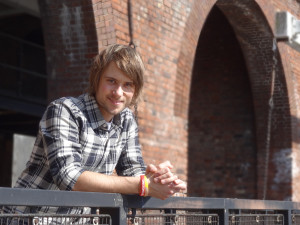This year I was somewhat grumpily wandering around BETT (it having changed very little from last time) when I was accosted by a stallholder. I grumpily tried out the product and found myself actually quite impressed with it as a simple but solid idea. I’ve invited Mark to talk about the design process here, but I’m first going to show you the ‘what it is video’:
https://www.youtube.com/watch?v=o8ua0UhvAMM
(there are lots of other great YouTube demos)
Even better, at the end of this post, you’ll get a chance to win one! 🙂
Now, over to Mark! 🙂
It was a bleak northern October morning at the end of a long half term. Being the most technically proficient teacher in the D&T department, I’d been asked to demonstrate our new laser cutter for an upcoming open evening and was mulling over possible freebies to cut and give away to parents. Key rings? Spaghetti measurers? Trolley pennies? They had mostly been done, badly and predictably by other local schools doing the very same thing. Our laser was a branny. Clean, shiny and only recently installed by the bloke who goes around to schools showing them they can now make their own plastic rulers. There was the spark – why not create a drawing tool that was actually relevant to our subject and put some useful little design quirks into it at the same time? I was a Product Design graduate after all; time to kick the design brain into gear.
‘EasySketcher’ was the product of that morning, and was an overly complicated and easily breakable concept, albeit with the seed of an idea that would later become a tool dedicated to 3D drawing. I’d included a 120° angle for doing quick isometric drawings when it hit me that this function alone could be used to create and modify a cube shape, thus underpinning any 3D sketch through the simple but effective principle of ‘crating’. A door swung open in my mind and revealed an opportunity for a product that simply did not exist in a capacity that kids this age could access. A cure for “I can’t draw”!
IsoSketch was born on a laser cutter soon thereafter, with several more prototypes being produced from ‘scrap’ acrylic that was conveniently under my control. The testing process then began with my own pupils – 4 ready made focus groups per day! Needless to say, they quickly realized this was a good idea, confirmed with cries of “that’s sick sir”. Lots of head scratching and 19 versions later, we had a winner.
I just had to work out how to afford an injection moulding tool. Luckily a group I’d been attending (Manchester Inventors group – MIG for short, or ‘the Masons’ as I lovingly referred to it) put me in touch with a gentleman who created the justification behind me being allowed a grant to help fund such an investment. Needless to say I smiled, shook his hand and took the quota that he was under pressure to shift from the Local Council’s regeneration budget. Production began in Blackburn in 2014 and hasn’t looked back since.
So that’s how it came to be, now for the why. IsoSketch was born out of teaching Design & Technology (Product Design, RM & Graphics) from Key Stages 3-5. The product addresses a part of the design process that is easy to overlook with an abundance of digital technology producing end results; the creation of a concept. Kids have varying amounts of patience, usually ranging from little to none. A kid who thinks they can’t draw will adopt that mindset until they see solid proof convincing them otherwise. A crap drawing looks crap, and this will continue to cement the mindset that D&T is not for them, despite the core purpose of design being the creation of ideas, not artwork.
The product works by providing a foolproof isometric guide to allow pupils to create super-accurate 3D sketches in very little time, which can easily be realized onto CAD thanks to their inherent accuracy. At the same time, the product works to teach the user how to construct a 3D shape with the ultimate goal of creating better sketchers and thus, confident designers.
Digital is everywhere. Schools are forking out for laser cutters, 3D printers, augmented reality software, exotic plastics and so on. It’s a crippling cost structure for a subject that used to revolve around relatively cheap materials and cheap, durable tools. I’ve been using the analogy that if 3D printing is the wedding, a good 3D sketch is the first date. If we want kids to produce meaningful products on 3D printers, we must equally encourage the development of 3D sketching skills. Without this, we’ll be laying the foundations for a nation of programmers and system controllers rather than designers and engineers. Drawing won’t go away, it won’t become old-fashioned. It will remain (as it was for cavemen) a vital form of immediate, recorded communication between the imaginary and physical worlds. It’s a critical stage in the process that ultimately ends in a finished prototype.
There. That’s my case for sketching, it’s as vital today as it was 50 years ago and 500 before that. Professional designers all sketch and so should our design students. The problem is we lose so many potentially great designers because they never get past thinking they can’t draw. That’s where teachers have become stuck in the past, with only so much as a piece of isometric grid paper to offer the “can’t draw” pupils.
IsoSketch is the old, new again. Breathing new life into a skill that is easy to forget when you’ve got snazzy machines spooling out mini-models of famous landmarks and people’s faces in 3D; but just as important – if not more so. Having an expensive wedding is one thing, but you’ll never forget the first date.
So we’ve got two IsoSketches to give away to a couple of lucky readers. On the 31st June I’ll generate a couple of random numbers and use those to pick a blog subscriber for the prize. So if you’d like to get your hands on one of the copies – then subscribe!



